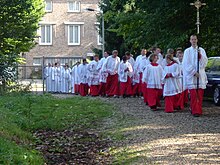|
Female altar servers The development of the ministry of altar server has a long history. By the early Middle Ages, some of these ministries were formalized under the term "minor orders" and (along with the diaconate) used as steps to priestly ordination. One of the minor orders was the office of acolyte.[1] Altar servers are a substitute for an instituted acolyte. In several Christian Churches, women have traditionally been excluded from approaching the altar during the liturgy. Thus The Service Book of the Orthodox Church (English translation by Isabel Florence Hapgood) states that "no woman may enter the Sanctuary at any time".[2] In the Roman Rite of the Catholic Church, the former rule was: "women may not enter [the sanctuary] at all".[3] This did not exclude women, especially in convents of nuns, from entering the altar area at other times, for cleaning. In Eastern Churches, women are further restricted by not being allowed inside the altar area and in several traditions even within the church building during their monthly periods.[4] Catholic ChurchFormer practiceFormerly, it was generally forbidden to have women serving near the altar within the sacred chancel (infra cancellos), that is, they were prohibited from entering the altar area behind the altar rails during the liturgy. In convents of nuns, women did serve within the chancel.[5] In his encyclical Allatae sunt of 26 July 1775, Pope Benedict XIV renewed the prohibition, "Women should not dare to serve at the altar; they should be altogether refused this ministry", stated more than five centuries earlier by Pope Innocent IV in his letter Sub catholicae professione of 6 March 1254 to Odo of Tusculum on Greek rites.[6] Pope Benedict XIV also stated that what he called the evil practice of women serving the priest at the celebration of Mass had been condemned also by Pope Gelasius I (492−496).[7]
With the practice of private Masses (Mass by a priest and one other person, often offered for a deceased person), scandal was an additional reason not to have a woman or girl alone with a priest. It is important to take note that both nuns and priest both have taken vows of celibacy for their lives. In the Catechism of the Catholic Church it states:
However, it has been customary in convents of women for nuns to perform the ministry of acolyte without being formally ordained to that minor order.This practice was used when the Council of Trent developed the seminary system where men in minor orders would go away to schools for training to be a priest rather than study under a parish priest. In 1963, all of the Catholic Church leaders were called together to meet in the Vatican, this was called: The Second Vatican Council. In this council, the Church leaders voted on many different topics such as: pastoral duties of bishops in the church, ministry and the life of priest, and addressed religious life issues. Another topic under discussion was allowing females to serve Mass. The leaders of the Church could not come to a decision on the matter so in 1980, the Church leaders set on the 1917 Code of Canon Law that stated: "A woman is not to be the server at Mass except when a man is unavailable and for a just reason and provided that she give the responses from a distance and in no way approach the altar."  In 1994, the Canon Law was being re-interpreted by The Pontifical Council for Legislative Texts. During this time, Pope John Paul II changed the Law allowing women and girls to serve as altar servers and the priest of the respecting churches could decided who they wished to altar serve a Mass, if they choose. The human body of the Church has not upheld the ideals of the mystical body of the Church, that which Jesus would have intended. (St.) Pope John Paul II said in his letter to women in 1995.
Changes since Vatican IIThe 1983 Code of Canon Law, without distinguishing between male and female, said that "Lay persons can fulfill the function of lector in liturgical actions by temporary designation. All lay persons can also perform the functions of commentator or cantor, or other functions, according to the norm of law."[9] Although that language did not explicitly authorize women to act as altar servers, many dioceses allowed females to act as altar servers.[citation needed] The Holy See provided two clarifications in the 1990s. On 30 June 1992, the Pontifical Council for the Interpretation of Legislative Texts issued an authentic interpretation of that canon declaring that service at the altar is one of the "other functions" open to lay persons in general.[10] On 15 March 1994, the Congregation for Divine Worship affirmed that both men and women may serve at the altar, that each bishop has the discretion to determine who may serve, and that "it will always be very appropriate to follow the noble tradition of having boys serve at the altar".[11][12] In the year 2021, the elected Pope, Pope Francis, modified the Canon Law to state that all baptized persons, male and female, of the Catholic Church were allowed to lector and acolyte. Where women and girls already had the ability to exercise these functions "by temporary designation", he indicated their eligibility for these roles "on a stable basis". Vatican and papal practice
Pope Benedict XVI had both male and female altar servers in Papal masses in London (2010), Berlin, and Freiburg (2011).[citation needed] United StatesIn the United States the Diocese of Lincoln, Nebraska is the only diocese that did not allow female altar servers,[13] after the only other diocese that did not, the Diocese of Arlington, ended its prohibition on female altar servers in 2006.[14] However, the cathedral of the Diocese of Phoenix announced in August 2011 that it would become another of the Catholic churches in which women would not be allowed to serve at the altar.[15] In 2015, Cardinal Raymond Leo Burke, an American official of the Roman Curia, criticized the introduction of female altar servers as part of what he calls "radical feminism" and a unwelcome sign of the "feminization" of the Church.[16] Burke says that it requires a "certain manly discipline to serve as an altar boy in service at the side of a priest, and most priests have their first deep experiences of the liturgy as altar boys. If we are not training young men as altar boys, giving them an experience of serving God in the liturgy, we should not be surprised that vocations have fallen dramatically."[17] Images of female servers
References[18] John, Paul II. (1995-06-29). Letter of Pope John Paul II to Women: The Holy See, Libreria Editrice Vaticana.
[19]Catechism of the Catholic Church (2nd ed.). (1997). Libreria Editrice Vaticana.
|




